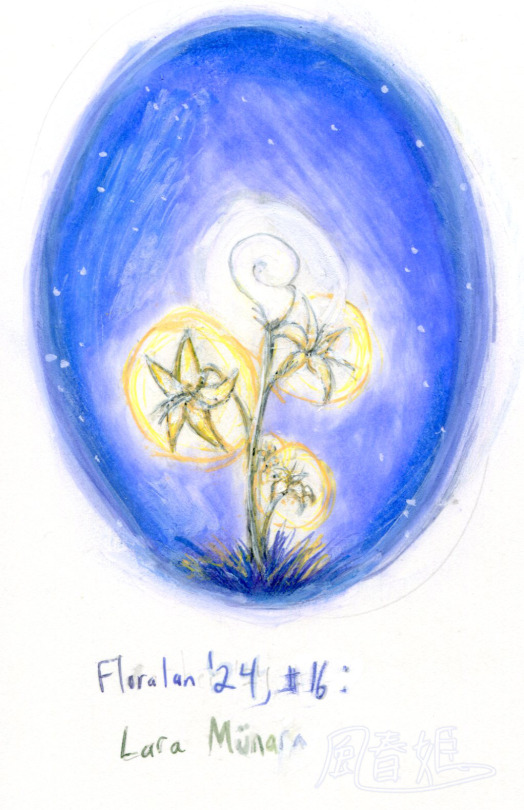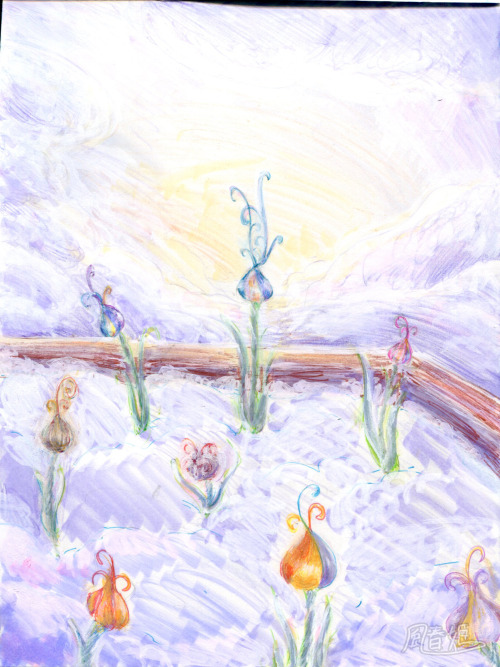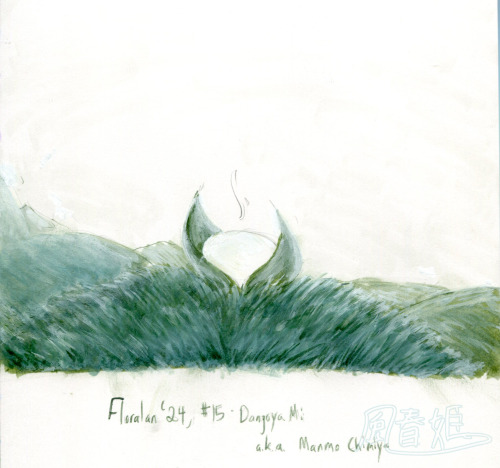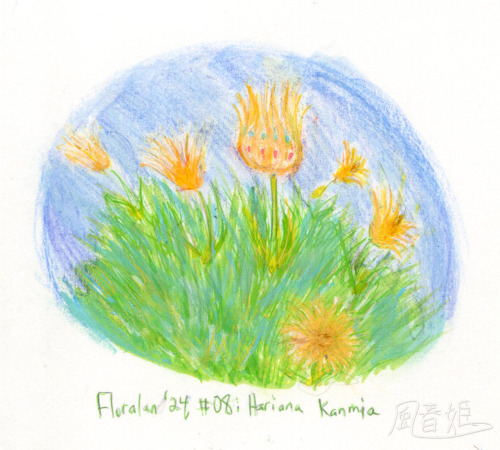Lara Mnara

Lara Münara
A relative of the Münlala Spikalif and Orbitania, the Lara Münara boasts of larger flowers than the latter and more Lar-like fruit than the former. The taste of its stem is distinctly plant-like, though it tastes slightly like that of an Omu-omu Plantai as well. The flowers make wonderful decorations, but are generally not used for more than decoration or garnish in when it comes to eating. They don't taste bad, but they don't have much a taste to speak of either.
The fruit is similar to that of the Münlala Spikalif and the Orbitania, but with less of a downy layer to it and a little more of a glass-like crunch to it. If it grew any closer to the mainland, it's possible the fruit would display more transparency as well.
-
 ciscandocinza liked this · 9 months ago
ciscandocinza liked this · 9 months ago -
 nessaspond liked this · 9 months ago
nessaspond liked this · 9 months ago -
 enjoliquej liked this · 9 months ago
enjoliquej liked this · 9 months ago -
 toothpaste-dragon liked this · 9 months ago
toothpaste-dragon liked this · 9 months ago -
 iggyfing liked this · 9 months ago
iggyfing liked this · 9 months ago
More Posts from Kazeharuhime

Twis-tia Petalia
Twis-tia Petalias were a once wild flowers that have been cultivated to grow in all sorts of different colors. The flower produces a nectar that hardens when exposed to air, producing a hard-candy-like substance within its flowers. The Twis-tia Petalia's close relative, the Sweetea Bundalia, does something similar, but has been cultivated to produce a hardening chocolate-like nectar instead of the honey-like substance that Twis-tia Petalias produce. As efforts to increase the number of Twis-tia Petalia and Sweetea Bundalia in JI continue, their delicious fruits can be expected to spread around JI as well.
How do you do the gradient colour text on tumblr?
Basically, I use this site to get a gradient text (to get more control over my gradient colors, I screenshot my draft post, load it up in PS [any program with layers, layer settings and gradients will work though], new layer set to screen, rectangle marquis the text, sample some colors from the pic for the gradient [or I might boost them/choose them myself/mess around with the sampled colors with color balance etc], apply gradient once or a few times to make adjustments if the initial one doesn't look nice [first is an opaque gradient, then one color with transparency to make adjustments unless it's really bad, then it's back to an opaque one and repeat process]. Once I'm happy with it I sample a color from each letter, line up the colors to sample from, then copy each hex code as I sample from the lineup and plug them into the site, adjusting for the number of letters), copy the html code once I'm happy with the gradient, then (on PC, but mobile browser works too) hit the gear on the top right corner of the draft editor, under text editor, hit the drop-down menu and select html. Go back to the draft editor, highlight the text to be gradiented, paste html in its place, hit the gear and go back to rich text under text editor, head back to the draft, see how it looks. If it looks bad, I go back into PS (or if you're not insane like me you could adjust it from the site, but I like knowing exactly what color what letter is going to be) and repeat the gradient and pasting processes. The process repeats until I'm happy with how it looks in the editor. Then I move on to finish the rest of my post

Heleh Lifurloa
If the Clera Fula signifies the start of the rainy season, the Heleh Lifurloa signifies the end. Its root system works tirelessly to help drain the land and stabilize the ground in the wake of the rainy season. In the dry months, however, it's nowhere to be seen. By what process it disappears has yet to be directly observed, but in particularly wet years when the Heleh Lifurloas are far and few in between, they are sometimes seen all year round, vanishing only when the ground around it is sufficiently drained.
It has long, string-like sticky pistils with which to collect wind-blown pollen as Heleh Lifurloas tend not to grow close together. It stores water in its stem, leaves, petals and tubers, which, aside from the petals, all share a glassy appearance. The leaves and tubers swell the more water they collect and shrink as the plant uses it up. The tubers can be shaped to create beautiful, decorative pieces. The leaves and stems are not so easily manipulated, but nevertheless make elegant, decorative pieces if caught before their mysterious disappearance.
The corolla is sometimes plucked to be used as a decorative container, similar to a Jara Flora. The nectar is used to sweeten tea themed around the flower during the Tea Festival. The leaves, stem and tubers can be melted and boiled down to create a slightly sweet syrup as well, but as the initial melted plant is full of water, it usually takes quite a while to boil it down to a syrup, and few parts of the plant are edible without processing. The pistils are trimmed and used to add a sweet, herbal note to tea themed around the plant.

Dangoya Mi a.k.a. Manmo Chimiya
Deeper exploration of the Reline Ah dimension (otherwise known as the Flower Buddy dimension) has revealed the existence of a misty land heated by geothermal heat on the border between it and the Fire Dimension. One plant that thrives here is the Dangoya Mi, or Manmo Chimiya. Its fruit, warmed by the ground, is piping hot and has a sticky consistency like that of a rice cake. When dried and fired, it can be drawn on, and residents of the land have been seen using them as decorations that way. As its taste is also similar to a sticky rice cake, it can be enjoyed as a savory item as well. The leaves that grow sheltering the fruit prove to be an artful decoration whether for use in serving or framing the dried fruit.

Hariana Kanmia
The Hariana Kanmia is said to be the origin of all the other Hariana species, including Hariana Stratasa (featured here around the Hariana Kanmia). There is only one known Kanmia, and similar to how the Magna Subariana is thought to be the heart of the Great Buddy Lake, the Kanmia is thought to be the heart of all other Harianas, and if something were to befall it, calamity would befall the entire genus. This is of course speculation, but it keeps the lone specimen protected from careless Kitonyas, Neonyas, and children nonetheless.
The Hariana Kanmia can be found only in Fuline Ah, deep in the continent in a field of other Hariana species, such as plain Harianas, Stratasas and Blosomas.